Scoliosis ICD-10-CM Codes | 2023
Discover the ICD-10 codes used for Scoliosis — vital for precise medical billing & record-keeping. Find codes for varying types of Scoliosis with Carepatron.

What ICD-10 Codes are Used for Scoliosis?
Scoliosis is a medical condition characterized by an abnormal lateral curvature of the spine. This condition necessitates a detailed coding system for precise medical billing and accurate record-keeping. Here are the most commonly employed ICD-10 codes for Scoliosis:
- M41.9: Scoliosis, unspecified: Applied when the documentation lacks detailed information about the type of Scoliosis. This code offers a broad categorization when the scoliosis type is uncertain.
- M41.12: Adolescent Idiopathic Scoliosis Covering approximately 80% of diagnosed cases, this code is used for Scoliosis that emerges between the ages of 10 and 18. No known single cause is associated with this form. This code acknowledges the challenge of diagnosing Scoliosis in adolescents due to the subtle postural changes and rare presence of pain.
- M41.00, Infantile Idiopathic Scoliosis: Used for infantile idiopathic Scoliosis diagnosed in infants between birth and age 3. While some instances of this condition resolve independently, it's crucial to document these cases accurately, as unresolved cases can progress to severe levels later in life.
- M41.11: Juvenile Idiopathic Scoliosis: This code is designated for Scoliosis diagnosed between the ages of 3 and 9. Considering the remaining growth these individuals have to experience, this age group faces a high risk of progression.
- M41.2: Additional Idiopathic Scoliosis Conditions: This code includes undetected conditions before the patient reaches skeletal maturity, typically around age 18. Cases of degenerative or adult 'de novo' Scoliosis also fall into this category, reflecting conditions that have developed after skeletal maturity with no prior history of the condition.
- Q76.3: Congenital Scoliosis Due to Congenital Bony Malformation: Employed when Scoliosis is congenital and attributable to a malformation in the vertebrae. Congenital Scoliosis disrupts the spine's alignment due to malformed vertebrae present at birth.
- Q67.5: Congenital Spinal Deformity: This code captures cases of congenital Scoliosis not due to a bone malformation, as well as other atypical congenital scoliosis cases.
- M41.4: Neuromuscular Scoliosis: This code encompasses Scoliosis arising from neuromuscular disorders such as cerebral palsy, muscular dystrophy, or spina bifida. It distinguishes Scoliosis, which develops as a secondary complication of these disorders.
- M41.30: Adolescent idiopathic Scoliosis, site unspecified: This code is applied when Scoliosis initiates in adolescence, and the specific site of the curve isn't specified.
Which Scoliosis ICD codes are Billable?
All the ICD-10 codes mentioned for Scoliosis are billable.
Clinical Information
- Scoliosis is a prevalent medical disorder marked by an abnormal, often S- or C-shaped, lateral curvature of the spine. This deviation from the spine's typical straight alignment can vary in severity and lead to various health issues.
- The onset of this condition typically coincides with the adolescent growth spurt just before puberty. This timing is crucial, as rapid growth can exacerbate the spinal curve, necessitating closer monitoring during these formative years.
- While most individuals diagnosed with scoliosis experience mild forms of the condition, a small percentage may develop severe Scoliosis. This extreme form can lead to significant physical discomfort, reduced range of motion, and, in rare instances, disability.
- Therapeutic interventions for Scoliosis vary based on the severity of the spinal curvature. In milder cases, children may be required to wear a specially designed brace. This non-invasive treatment aims to halt the progression of the spinal curve and is most effective when initiated early.
- Surgical intervention may become necessary for more severe spinal curves or instances where bracing fails to halt curve progression. Spinal fusion surgery is the most commonly performed procedure for severe Scoliosis. It aims to correct the curve and secure the spine, preventing further progression.
Commonly asked questions
When a patient is diagnosed with Scoliosis or is being treated for Scoliosis, the appropriate ICD code should be used.
Yes, scoliosis diagnoses are billable with the appropriate ICD-10 codes.
Treatments range from watchful waiting for mild cases to bracing for moderate Scoliosis and surgery for severe cases.
A diagnosis code for Scoliosis signifies the type and origin of the Scoliosis for accurate medical billing and tracking of the patient's condition.

.jpg)





.webp)
.webp)
.webp)
.webp)
.webp)
.webp)
.webp)
.webp)
.webp)
.webp)
.webp)
.webp)
.webp)
.webp)
.webp)
.webp)
.webp)
.webp)
%2520(1).webp)
.webp)
.webp)
.webp)
.webp)
.webp)
.webp)
.webp)
.webp)
.webp)
.webp)
.webp)
.webp)
.webp)
.webp)
.webp)
%2520(1).webp)
.webp)
.webp)
.webp)
.webp)
.webp)
.webp)
.webp)
.webp)
.webp)
.webp)
.webp)
.webp)
.webp)
.webp)
.webp)
.webp)
.webp)
.webp)
.webp)
.webp)
.webp)
.webp)
.webp)
.webp)
.webp)
.webp)
.webp)
.webp)
.webp)
.webp)
.webp)
.webp)
.webp)
.webp)

.webp)
.webp)
.webp)
.webp)
.webp)












.webp)
.webp)




.webp)


